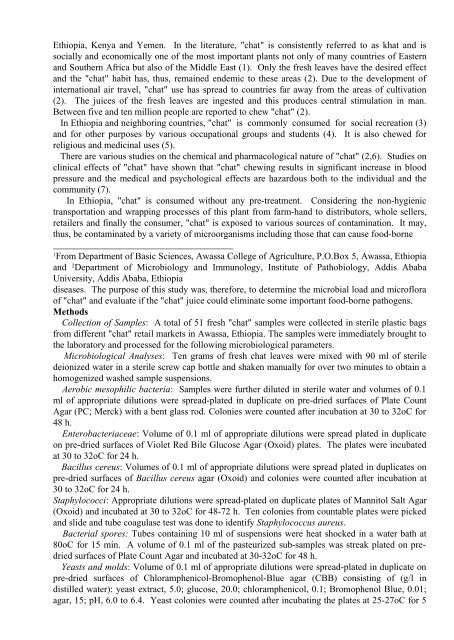Original article - Ethiopian Review
Original article - Ethiopian Review
Original article - Ethiopian Review
- No tags were found...
Create successful ePaper yourself
Turn your PDF publications into a flip-book with our unique Google optimized e-Paper software.
Ethiopia, Kenya and Yemen. In the literature, "chat" is consistently referred to as khat and issocially and economically one of the most important plants not only of many countries of Easternand Southern Africa but also of the Middle East (1). Only the fresh leaves have the desired effectand the "chat" habit has, thus, remained endemic to these areas (2). Due to the development ofinternational air travel, "chat" use has spread to countries far away from the areas of cultivation(2). The juices of the fresh leaves are ingested and this produces central stimulation in man.Between five and ten million people are reported to chew "chat" (2).In Ethiopia and neighboring countries, "chat" is commonly consumed for social recreation (3)and for other purposes by various occupational groups and students (4). It is also chewed forreligious and medicinal uses (5).There are various studies on the chemical and pharmacological nature of "chat" (2,6). Studies onclinical effects of "chat" have shown that "chat" chewing results in significant increase in bloodpressure and the medical and psychological effects are hazardous both to the individual and thecommunity (7).In Ethiopia, "chat" is consumed without any pre-treatment. Considering the non-hygienictransportation and wrapping processes of this plant from farm-hand to distributors, whole sellers,retailers and finally the consumer, "chat" is exposed to various sources of contamination. It may,thus, be contaminated by a variety of microorganisms including those that can cause food-borne______________________________________1From Department of Basic Sciences, Awassa College of Agriculture, P.O.Box 5, Awassa, Ethiopiaand 2 Department of Microbiology and Immunology, Institute of Pathobiology, Addis AbabaUniversity, Addis Ababa, Ethiopiadiseases. The purpose of this study was, therefore, to determine the microbial load and microfloraof "chat" and evaluate if the "chat" juice could eliminate some important food-borne pathogens.MethodsCollection of Samples: A total of 51 fresh "chat" samples were collected in sterile plastic bagsfrom different "chat" retail markets in Awassa, Ethiopia. The samples were immediately brought tothe laboratory and processed for the following microbiological parameters.Microbiological Analyses: Ten grams of fresh chat leaves were mixed with 90 ml of steriledeionized water in a sterile screw cap bottle and shaken manually for over two minutes to obtain ahomogenized washed sample suspensions.Aerobic mesophilic bacteria: Samples were further diluted in sterile water and volumes of 0.1ml of appropriate dilutions were spread-plated in duplicate on pre-dried surfaces of Plate CountAgar (PC; Merck) with a bent glass rod. Colonies were counted after incubation at 30 to 32oC for48 h.Enterobacteriaceae: Volume of 0.1 ml of appropriate dilutions were spread plated in duplicateon pre-dried surfaces of Violet Red Bile Glucose Agar (Oxoid) plates. The plates were incubatedat 30 to 32oC for 24 h.Bacillus cereus: Volumes of 0.1 ml of appropriate dilutions were spread plated in duplicates onpre-dried surfaces of Bacillus cereus agar (Oxoid) and colonies were counted after incubation at30 to 32oC for 24 h.Staphylococci: Appropriate dilutions were spread-plated on duplicate plates of Mannitol Salt Agar(Oxoid) and incubated at 30 to 32oC for 48-72 h. Ten colonies from countable plates were pickedand slide and tube coagulase test was done to identify Staphylococcus aureus.Bacterial spores: Tubes containing 10 ml of suspensions were heat shocked in a water bath at80oC for 15 min. A volume of 0.1 ml of the pasteurized sub-samples was streak plated on predriedsurfaces of Plate Count Agar and incubated at 30-32oC for 48 h.Yeasts and molds: Volume of 0.1 ml of appropriate dilutions were spread-plated in duplicate onpre-dried surfaces of Chloramphenicol-Bromophenol-Blue agar (CBB) consisting of (g/l indistilled water): yeast extract, 5.0; glucose, 20.0; chloramphenicol, 0.1; Bromophenol Blue, 0.01;agar, 15; pH, 6.0 to 6.4. Yeast colonies were counted after incubating the plates at 25-27oC for 5




![to read the full report [pdf, Amharic] - Ethiopian Review](https://img.yumpu.com/52737829/1/190x245/to-read-the-full-report-pdf-amharic-ethiopian-review.jpg?quality=85)











